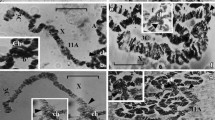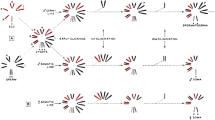Abstract.
Classic recessive position effect variegation is related to inactivation of genes juxtaposed to heterochromatin and accompanied by cytologically visible heterochromatization (compaction) of the chromosome region containing these genes. Compaction and gene inactivation occur only in the rearranged homologue. In contrast to this, dominant variegation of the bw gene is known to involve transcriptional silencing in both the cis and trans copy, if they are paired. Our paper describes a cyto- logical approach to understanding this phenomenon. Analysis of salivary gland chromosomes carrying In(2R)bw VDe1 and In(2R)bw VDe2, evoking strong dominant bw variegation, has shown that in the rearranged homologues typical heterochromatization of the bw region and proximal neighbouring bands occurs. Heterochromatization was never observed on a normal homologue paired with a rearranged one. The insertion into the chromosome region 59E in the bw D strain is similar to pericentric heterochromatin. The insertion seems to induce heterochromatization of the neighbouring chromosome region and as a result the material of the insert and the 59E1–2 band join into a single block. When variegation is suppressed, the 59E1–2 band can be seen as a separate structure located proximal to the insert. This occurs in salivary gland polytene chromosomes of XYY males at 29°C and in pseudonurse cell polytene chromosomes of otu 11/otu 11 females. All bands in the region of the non-rearranged homologue show normal morphology. Thus, although in all strains studied we observed heterochromatization in cis, the homologous regions in trans are not visibly affected.
Similar content being viewed by others
Author information
Authors and Affiliations
Additional information
Received: 29 March 1996; in revised form: 28 December 1996 / Accepted: 2 February 1997
Rights and permissions
About this article
Cite this article
Belyaeva, E., Koryakov, D., Pokholkova, G. et al. Cytological study of the brown dominant position effect. Chromosoma 106, 124–132 (1997). https://doi.org/10.1007/s004120050232
Issue Date:
DOI: https://doi.org/10.1007/s004120050232




